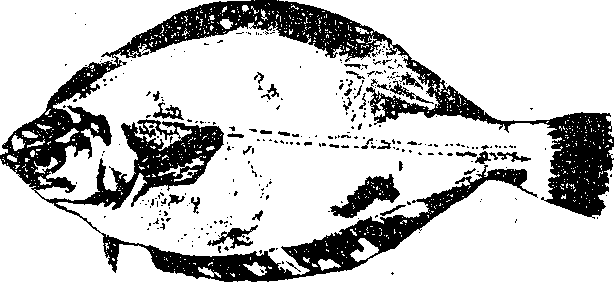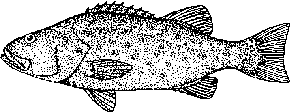
- •Offshore fishes
- •Sanddabs
- •California halibut
- •4 Kelp bass
- •California barracuda
- •California yellowtail
- •7 Pacific jack mackerel Trachurus symmetricus
- •8 Pacific mackerel Scomber japonicus
- •9 California bonito (Sarda chiliensis)
- •10 Tuna, bluefin
- •11 Albacore
- •12 White seabass
- •13 White croaker Genyonemus lineatus
- •14 Ocean whitefish
- •15 Sheep-head
- •1 6 Bocaccio Sebastes paucispinis
- •17 Olive rockfish
Offshore fishes
![]()
By JOHN E. FITCH
Sanddabs

Distinguishing characteristics. Sanddabs belong to the left-eyed flounder family as do California halibut, fantail sole, and bigmouth sole. Although three kinds of sanddabs live in the waters off our coast, only two are commonly used for food; the third never grows longer than about five inches and important mainly in the diet of other fishes. The Pacific sanddab can best be distinguished from the longfin sanddab by the length of pectoral fin on the eyed side. It is always shorter than the head of the longfin. Sanddabs are always left "handed" and can be distinguished from all other left "handed" flatfish by having a lateral line that is nearly straight for its entire length.
Distribution. Sanddabs normally live on sandy or sandy-mud bottoms all the way from Alaska to the tip of Baja California. They seldom inhabit water that is shallower than 10 fathoms or deeper than 100. They are most abundant at depth of 20 to 50 fathoms.
Life history notes. Sanddabs are said to reach an age of at least 10 years and to attain a weight of two pounds. An 11.5-inch female recently captured in Santa Monica Bay was nine years old and weighed over one-half pound. Females grow faster and bigger than males and normally mature when three years old and around seven and one-half inches long. The sex of a sanddab, can be determined by holding the fish up to a strong light. In the females the long ovary lies along the ventral contour and extends well back into the body of the fish. During the peak of the spawning season, which is July, August, and September, the females spawn numerous eggs which are between 0.57 and 0.77 millimeters in diameter (there are 25 millimeters in an inch). Each fish probably spawns more than once during a season.
Sanddabs eat a wide variety of food. In addition to such items as small fish, squid, and octopi, they eat an assortment of eggs, pyrosomes, shrimp, crabs, and marine worms. They in turn are preyed upon by many species of large, voracious fishes during all stages of their life. The very early young live a pelagic life and are often caught in plankton nets many miles from shore. These pelagic larvae are sometimes fed upon by albacore and other pelagic species.
Sanddab otoliths (earbones) have been found in Miocene deposits near Bakersfield. These remains were deposited between 20 and 40 million years ago.
California halibut

Although a member of the lefteyed flounder family, the California halibut has a habit of being righteyed over 40 percent of the time. Whether lefteyed or righteyed,it can be separated easily from all the other flatfish that live off our California coast because it has numerous sharp teeth in a very large mouth in combination with a high arch in the lateral line above the pectoral fin. Occasionally one encounters a California halibut that is brown on both sides, or white on both sides (albinistic).
Distribution. California halibut are most abundant on sandy bottoms in water shallower than 10 fathoms. They are found from Klamath River, California, to Magdalena Bay; Baja California. At times they are especially plentiful in the fast running channels of Morro Bay and Mission Bay. At other times they are caught in surf along open exposed beaches or in areas of rocky bottoms and rugged shorelines. Large halibut appear to have a preference for dense beds in shallow waters just outside the surf.
Life history notes. The California halibut is the largest species of this genus known in American waters, both Atlantic and Pacific. There is an unverified report of a 72-pounder but the recognized record is a 61,5-pound fish that was about five feet long. The age of a fish such as this is not known, but the scales of a 30-pound halibut showed 15 rings, indicating an age of 15 years. Males first mature when two or three years of age, but females do not mature until four or five. A five-year-old fish may be anywhere from 11 to 17 inches long. Spawning takes place in relatively shallow-water during the months of April through July.
California halibut do not travel extensively, especially when they are young. The preliminary results of a tagging program conducted by the Department of Fish and Game show that the larger and older halibut tend to move the greatest distances. Of 7000 fish tagged through 1957, there were 350 recoveries and only one of these had moved as much as 80 miles. More than 90 percent of the recaptured fish had not traveled more than a mile from the point of release.
Halibut feed almost exclusively upon anchovies and similar small fishes and at times are observed near the surface of the water as they make passes at anchovy schools. They are fed upon by several kinds of predaceous animals, including angel sharks, electric rays, sea lions, and Pacific bottlenose dolphins.
The earbones of California halibut have been found in Pliocene deposits near San Diego and San Pedro that were laid down some 12 to 20 million years ago.
--------------------------
indicate-conduct-tend-include-view-contain-serve-complete- consist of - vary-introduce-reproduce-affect-cause-confuse
3 GIANT SEA BASS
Stereolepis gigas

Distinguishing characteristics. This giant is a member of the bass family which includes such piscatorial prizes as striped, kelp and various other saltwater basses, groupers, and cabrilla. Large and smallmouth bass of freshwater lakes and streams are not members of this family. The giant sea bass is the only bass living off the California coast that has more spines than soft rays in the dorsal fins. There are 11 spines and or 10 soft rays.
Young specimens up to about six inches in length are of brick-red color and have six irregular rows of black polka dots on their sides. These polka dots are still evident in very large adults when observed in natural surroundings but soon fade upon removal of the fish from the water. Large fish are quite dark when viewed anywhere except under water in a live condition.
Distribution. They are occasionally taken along our coast from Humboldt Bay south and they range to and into the Gulf of California. They are most abundant at Anacapa, San Nicolas, and Los Coronados Islands and between Ocean-side and San Clemente on the mainland. Market fishermen claim that giant sea bass prefer a rocky bottom just outside a kelp bed where the water is 19 to 23 fathoms deep. Small fish often frequent inshore areas where the bottom is sandy.
Life history notes. The currently recognized world record giant sea bass weighed 563.5 pounds; it was caught at Anacapa Island in August 1968. No information is available regarding the age of this fish, but a 7-foot, 539-pounder that was beached at San Clemente in 1963 was about 60 years old, considerably younger than the 72 to 75 years determined for a 435-pounder.
Giant sea bass apparently do not mature until they are 11-13 years old. A fish of this age will weigh between 50 and 60 pounds. The ovaries of a 320-pound female taken in 1958 weighed 4-7 pounds and contained as estimated 60 million eggs. This fish was ready to spawn and the largest eggs were about one-twenty-fifth of an inch in diameter. The main spawning season for giant sea bass occurs during July, August, and September.
Giant sea bass feed upon a wide variety of items. The stomachs of small fish taken off our coast contained mostly anchovies and white croakers. Mackerel scad, jack mackerel, sheep-head, ocean whitefish, sand bass, cander crabs, and pelagic red crabs have all been found in the stomachs of large giant sea bass.
